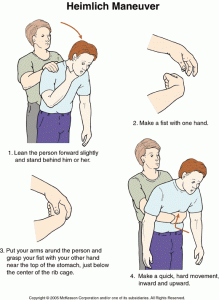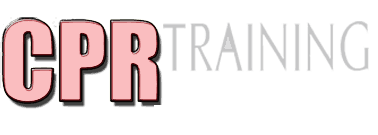
Every five days, at least one child dies from choking on food in the United States, whereas more than 10, 000 are brought to the hospital emergency room every year accounting for 70% of all total choking related injuries. According to Hutton (2012), the top 9 choking foods are hotdogs, carrots, apples, grapes, nuts, peanut butter, marshmallows, gum and hard candy, and popcorn. Other common non-food choking hazards include batteries, magnets, balloons, small toys, coins, marbles, small stones and art supplies (Sokoloff 2012).
When a foreign object gets stuck in the throat or windpipe, choking occurs, blocking the flow of airway. Choking deprives the brain of oxygen hence it is important to give first aid as soon as possible. The common sign for choking is clutching the hands to the throat. However, if this signal is not given, there are other signs: inability to talk, breathing noisily or difficulty in breathing, bluish or dusky skin, lips and nails, and loss of consciousness. You can also have your stand alone CPR training and have your certificate after it.
St Mark James recommends a “five-and-five” approach into giving first aid to a choking victim, which entails of giving five back blows and five abdominal thrusts. First give five back blows in between the person’s should blades. After, give five abdominal thrusts, also popularly known as Heimlich maneuver. Alternatively perform the five blows and five thrusts until the foreign object is removed.
To perform the Heimlich maneuver on someone else, one must stand behind the person and wrap both arms around the waist. Slightly tip the person forward. With one hand, make a fist and place it slightly above the person’s navel, approximately two inches. Using the other hand, grasp the fist. Press hard into the abdomen with a swift, upward thrust. This is as if seemingly trying to lift the person up. A total of five abdominal thrusts should be performed before again giving give back blows. If the person becomes unconscious, commence CPR with chest compressions and rescue breaths.
Moreover, it is possible to perform Heimlich maneuver on one’s self. If one is alone and one begins to choke, immediately call for medical help. Although one is incapable of giving effective back blows to one’s self, abdominal thrusts are doable in order to remove the foreign item. To do this, position a fist approximately two inches above the navel. Using the other hand, grasp the fist and bend over a hard surface, such as a chair or countertop. Shove the first in an inward and upward motion. CPR re-certification is important so you have to re-apply immediately once your certificate expires.
To perform Heimlich maneuver on an obese person or pregnant woman, the hands must be placed slightly higher than the normal Heimlich, at the lower of the breastbone, above the joining base of the ribs. Continue with Heimlich maneuver, pressing hard into the chest with a swift thrust. Continue doing so until the foreign object is removed or the person becomes unconscious.
Here is a video on How To Perform the Heimlich Maneuver (Abdominal Thrusts)
[media url=”http://www.youtube.com/watch?v=tEIiEAn7b-U” width=”600″ height=”400″]However, if the person is unconscious, the person must be lowered with his/ her back on the floor to clear the airways. If the blockage is evident at the back of the throat, use the fingers to reach into the mouth and remove the blockage. Although one must take extra caution in order to not push the object deeper into the airway. If the object remains stuck and no response is given, perform CPR. Chest compressions in CPR may remove stuck object. Check the mouth occasionally.
If the choking victim is an infant younger than age one, take a seated position and place the child on the forearm while resting on the thigh. Hold the infant facing down. Gently but firmly thump the infant using the heel of the hand on the middle of the back. If the aforementioned does not work, hold the infant facing upward on the forearm with the head below the trunk level. Place two fingers are the center of the infant’s breastbone and give five fast chest compressions. Perform the back blows and chest thrusts again if there is no breathing. Call for emergency help. If neither technique opens the airways but does not result to breathing, begin infant CPR.
To better prepare self for these situations, Heimlich maneuver and CPR courses can be learned in first aid certification offered by St Mark James programs.
[note color=”#FFCC00″]CPR Training Courses references for this article:[/note]Hutton L. [Internet]. 2012. Top 9 choking foods. New Jersey (US): Pearson Education; [cited 2013 Jun 07] Available from: http://life.familyeducation.com/slideshow/safety/65468.html
Sokoloff AM. [Internet]. 2012. 10 most common choking hazaards. Atlanta (GA): Baby Gooroo; [cited 2013 Jun 07] Available from: http://babygooroo.com/2012/08/10-most-common-choking-hazards/
